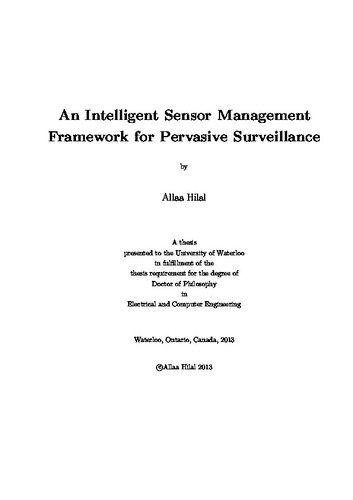| dc.description.abstract | The nature and complexity of the security threats faced by our society in recent years have made it clear that a smart pervasive surveillance system constitutes the most effective cure, as it presents a conducive framework for seamless interaction between preventative capabilities and investigative protocols. Applications such as wild-life preserve monitoring, natural disaster warnings, and facility surveillance tend to be characterized by large and remote geographic areas, requiring large numbers of unattended sensor nodes to cover the volume-of-interest. Such large unattended sensor networks add new challenges as well as complicate the system management problem. Such challenges can be in the form of distributed operation with collaborative decision making, adaptive performance, and energy-aware strategies, to name a few. To meet the challenges of these mission-critical applications, the sensor system must exhibit capabilities such as heterogeneous and self-organized behaviour, data and information fusion, and collaborative resources control and management.
Sensor Management (SM) refers to the process that plans and controls the use of the sensor nodes in a manner that synergistically maximizes the success rate of the whole system in achieving the goals of its mission in assessing the situation in a timely, reliable, and accurate fashion. Managing heterogeneous sensors involves making decisions and compromises regarding alternate sensing strategies under time and resource availability constraints. As a result, the performance of the collective sensors dictates the performance of the entire system. Consequently, there is a need for an intelligent Sensor Management Framework (SMF) to drive the system performance. SMF provides a control system to manage and coordinate the use of sensing resources in a manner that maximizes the system success rate in achieving its goals. An SMF must handle an overwhelming amount of information collected, and adapt to the highly dynamic environments, in addition to network and system limitations.
This thesis proposes a resource-aware and intelligent SMF for managing pervasive sensor systems in surveillance context. The proposed SMF considerably improves the process of information acquisition by coordinating the sensing resources in order to gather the most reliable data from a dynamic scene while operating under energy constraints. The proposed SMF addresses both the operation of the coordination paradigm, as well as, the local and collaborative decision making strategies. A conceptual analysis of the SM problem in a layered structure is discussed to introduce an open and flexible design framework based on the service-oriented architecture to provide a modular, reusable, and extendable framework for the proposed SMF solution. A novel sensor management architecture, called Extended Hybrid Architecture for Sensor Management (E-HASM), is proposed. E-HASM combines the operation of the holonic, federated, and market-based architectures in a complementary manner.
Moreover, a team-theoretic formulation of Belief-Desire-Intention (BDI), that represent the E-HASM components, is proposed as a mechanism for effective energy-aware decision making to address the local sensor utility. Also, intelligent schemes that provide adaptive sensor operation to the changes in environment dynamics and sensor energy levels are designed to include adaptive sleep, active sensing, dynamic sensing range, adaptive multimodality, and constrained communication. Furthermore, surveillance systems usually operate under uncertainty in stochastic environment. Therefore, this research formulates the collaborative decision-making entities as Partially Observable Markov Decision Processes (POMDP). To increase the tracking quality and the level of the information reliability, cooperation between the sensors is adopted, which adds an extra dimension in the design of the proposed SMFs. The propose SMF is implemented using the Jadex platform and is compared to the popular centralized architecture. The results illustrate the operation of the proposed SMF outperforms in terms of tracking quality, detection rate, energy consumption, network lifetime, and scalability. | en |

